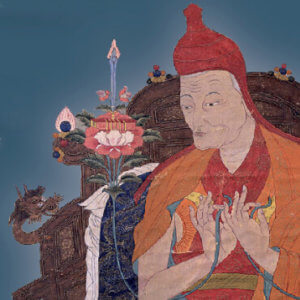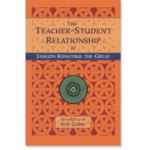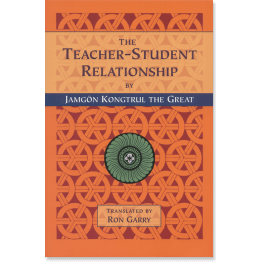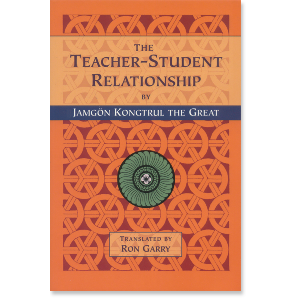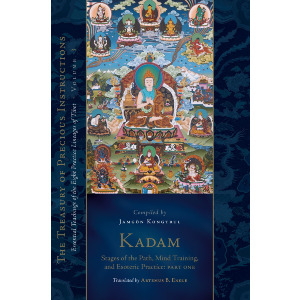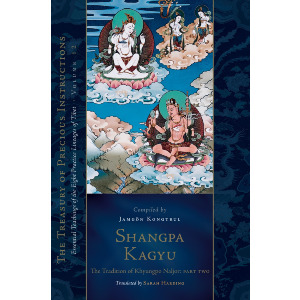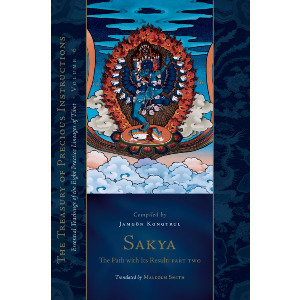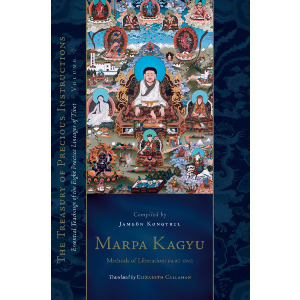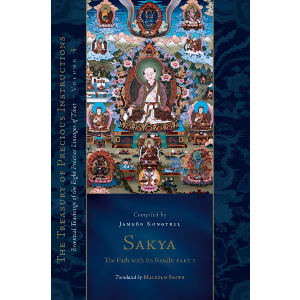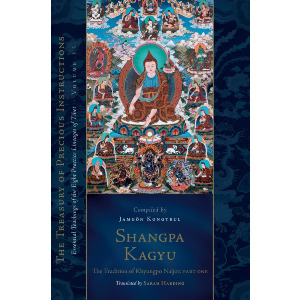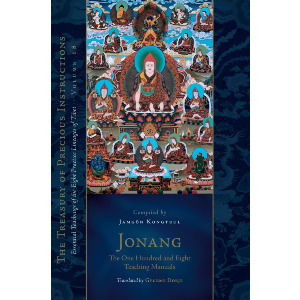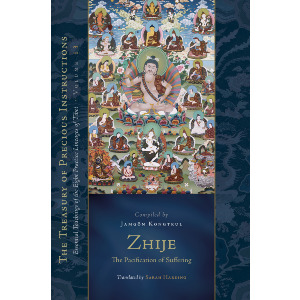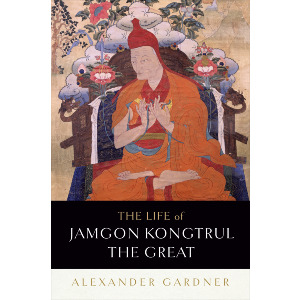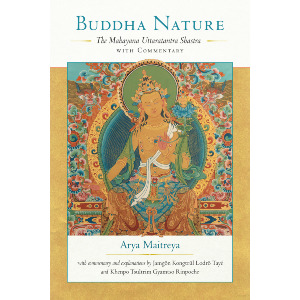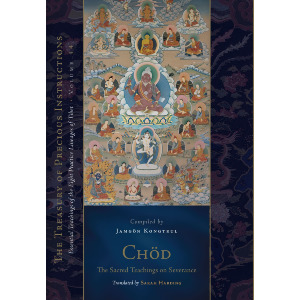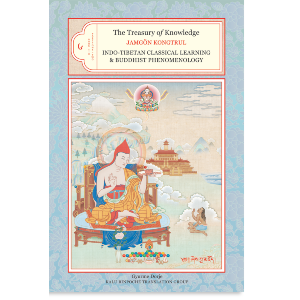| The following article is from the Spring, 1998 issue of the Snow Lion Newsletter and is for historical reference only. You can see this in context of the original newsletter here. |
By Jamgon Kongtrul Lodro Taye
Foreword by Lama Tharchin
Introduction by Gyatrul Rinpoche
Translated by Ron Garry
In the Tantric Buddhism of Tibet, it is an abiding principle that the root of all good qualities is devotion to a fully qualified spiritual friend (a teacher or gum). Nonetheless, in the few decades that Tibetan Buddhism has begun to blossom in the West, numerous problems have arisen between students and their teachers that seem to call into question what should be a relationship of mutual devotion, honesty, and respect.
The formidable challenge of finding the right teacher, and for teachers to find the right students, has actually been of major concern to Buddhists for many centuries, and the topic was never more thoroughly explored, and the answers more clearly delineated, than they were by the unsurpassed Tibetan teacher, Jamgon Kongtrul, in a chapter of his monumental Buddhist encyclopedia, The Treasury of Knowledge.
Translated by Dr. Ron Garry, this essential text lays out in clear terms the credentials and qualities that every student should look for in their teacher, why a teacher is necessary, and how the relationship between guru and disciple is to develop once it is established. With chapters such as How to Seek the Spiritual Friend, Why is a Teacher Necessary, Categories and Qualifications of Ihe Master, and How the Student. Should Choose a Teacher, the translation of this authoritative work puts into the hands of every student all they need to know to undertake the most fundamental and important step on the path: finding a qualified spiritual teacher.
Dr. Garry's introductory commentary unpacks Kongtrul's text and elaborates many essential points, drawing especially on Gampopa's Jewel Ornament of Liberation and Buton's Jewelry of Scripture. This important volume is introduced by two of the most respected lamas teaching in America today, Lama Tharchin Rinpoche and Gyatrul Rinpoche.
Jamgon Kongtrul Lodro Tayí© (1813-1899), a pivotal figure in eastern Tibet's nonsectarian movement, was one of the most outstanding writers and teachers of his time. In his' monumental Encyclopedia of Buddhism (Treasury of Knowledge) he presents a complete account of the major lines of thought and practice that comprise Tibetan Buddhism.
Other books by Jamgon Kongtrul: Enthronement: The Recognition of the Reincarnate Masters of Tibet and the Himalayas; Jamgon Kongtrul's Retreat Manual] Myriad Worlds: Buddhist Cosmology in Abhidharma, Kalachakra and Dzogchen; Buddhist. Ethics.
Following is an excerpt from The Student-Teacher Relationship entitled How to Properly Follow the Teacher.
Kongtrul states that the teacher-student relationship is created and nurtured in two steps. First there should be a careful, mutual examination by the teacher and the student, then they should enter into a relationship. Through it, the student attains enlightenment and the teacher fulfills his commitment to guide sentient beings to enlightenment; thus it is very important for the relationship to be pure, uncontaminated with negativity, and unbroken.
He explains that examining the relationship is important, because if a relationship is begun with an unqualified teacher or student, both will break their samaya and they will have many problems. Kongtrul quotes from the Fifty Stanzas on Guru Devotion to emphasize the importance of a good relationship between the teacher and the student:
Because the lama and his students will fail together in the samaya, in the beginning, the warrior should examine the relationship of the master and the student.

He also enumerates the many problems the student will encounter if he receives empowerments from an unqualified lama: the student will be led down the wrong path; he will not be able keep his samaya; he will not be able to attain the siddhis; his precious human rebirth will be squandered.
Thus, Kongtrul emphasizes that it is necessary for both the teacher and the student to examine each other before committing to a relationship. Many of us in the West, practicing on various spiritual paths, leap into the teacher-student relationship, then begin examining our teacher and find faults. Often the student becomes angry and leaves the relationship, feeling hurt and speaking negatively about the teacher. Had the student examined the teacher initially, this problematic situation might not have arisen. This tendency is not confined to Western students. In fourteenth century Tibet Kun Khyen Longchenpa wrote:
First, when the relationship is new, they recklessly get involved without examination. They speak of each of the lama's noble qualities, but later on there is only recrimination. For some, whatever they do is mixed with deception and backbiting, and they dishearten the close circle [of disciples) around the lama; for them the result is the lowest hell itself.60
Thus, it is necessary for a Buddhist student in the Tibetan tradition to be familiar with the traditional lists given by Kongtrul of the qualities which characterize the qualified teacher.

Although it is important to be generous with offerings and to pay respect to the spiritual friend, the best offering is to put his teachings into practice and thereby attain enlightenment for the benefit of all sentient beings.

After examining a teacher, the student may choose not to enter into a relationship for two primary reasons: the teacher is unqualified, as Kongtrul previously described; or, although he is qualified, his style or personality may not be suitable for that particular student. To determine whether or not the teacher is qualified, the student should refer to chapters three and four, above, in which Kongtrul describes the authentic teacher.
On the second point, although, in the present work, Kongtrul does not refer to the style or personality of the lama, it is frequently mentioned in the oral instructions given by lamas. Khenpo Tsultrim Gyamtso Rinpoche illustrated this point with an example of an unharmonious match between a teacher who likes to focus upon logic and philosophy, and a student who prefers meditation practice.
Kongtrul states that after the student has examined the teacher and has decided he is both qualified and suitable, he should then fully rely upon that teacher as the necessary condition (rkyeri) for attaining enlightenment. Gampopa, in An Ornament to Precious Liberation, writes:
although you may possess the most perfect support [rten, the precious human body], but are not urged on by spiritual friends as a condition (for attaining enlightenment], it is difficult to set out on the path towards enlightenment, because of the power of habitual tendencies (bagchags) due to bad deeds committed repeatedly in former times.
In order to correctly rely upon the teacher, the student must have the proper attitude and then apply herself toward following the teacher. Kongtrul states that the proper attitude is to rely upon the spiritual friend in order to attain complete enlightenment. It is important that the student is not motivated to enter a relationship with a lama by the desire for personal gain; for example, the desire to gain respect by being associated with a great teacher.
Kongtrul writes that after having established the proper attitude, the student then follows the lama through action. He enumerates three principle methods for following the lama: giving material things and honor; paying respect; and following the lama by means of practicing his teachings. He explains that the student should be willing to offer the lama all his material possessions. The traditional texts state that an advanced disciple, such as Naropa, Marpa, or Milarepa, would offer everything to his lama, including his wife, children, or his own body, speech, and mind. For most students today however, these types of offerings are not only not expected, but strongly discouraged.
Honoring the lama means that the disciple is respectful. When the lama enters the room the student stands until the lama sits down, and then the student offers three prostrations. Also, upon entering a room where the lama is present the student should prostrate three times. Because the student treats his teacher as if he is the Buddha himself, he will not use the teacher's utensils, clothing, or sit on his teacher's cushion. In the teacher's presence, it is considered disrespectful for the student to lie down, yawn without covering his mouth, or to sit on the floor with his feet pointing towards the teacher.
Paying respect includes the various things a student can do for the teacher. In Tibet, for example, a student might have the opportunity of bathing or massaging the teacher. In the West, paying respect may include running errands, doing chores, helping carry things for the teacher, and so forth.
Traditionally, the most important way of following the teacher is to carry out all his instructions and advice concerning dharma practice. To this effect Kongtrul states:
Cheerfully practicing all the commands (bsgo-ba) given by the lama, and assiduously practicing whatever possible in the way of listening (thos), contemplating (bsam), and meditating (sgom) upon all the dhamia teachings, is better worship (bsnyen-bkur) than the ways previously mentioned, because the true spiritual friend is to be pleased by the offering of practice, and not by goods and so forth.
Patrul Rinpoche, in The Oral Instructions of My Excellent Lama, reiterates that the best offering is one of practice:
Although the lama is pleased by three types of service, it is said that the supreme type is the offering of practice. This means persevering in the practice of all the teachings taught by the lama and enduring all hardships. The intermediate way of rendering service is serving your lama by doing whatever he wants you to do with your body, speech, and mind. The lowest way to please your lama is by making generous offerings of material things such as food and wealth.71
Therefore, we are shown that although it is important to be generous with offerings and to pay respect to the spiritual friend, the best offering is to put his teachings into practice and thereby attain enlightenment for the benefit of all sentient beings.
The Teacher-Student Relationship
$24.95 - Paperback
